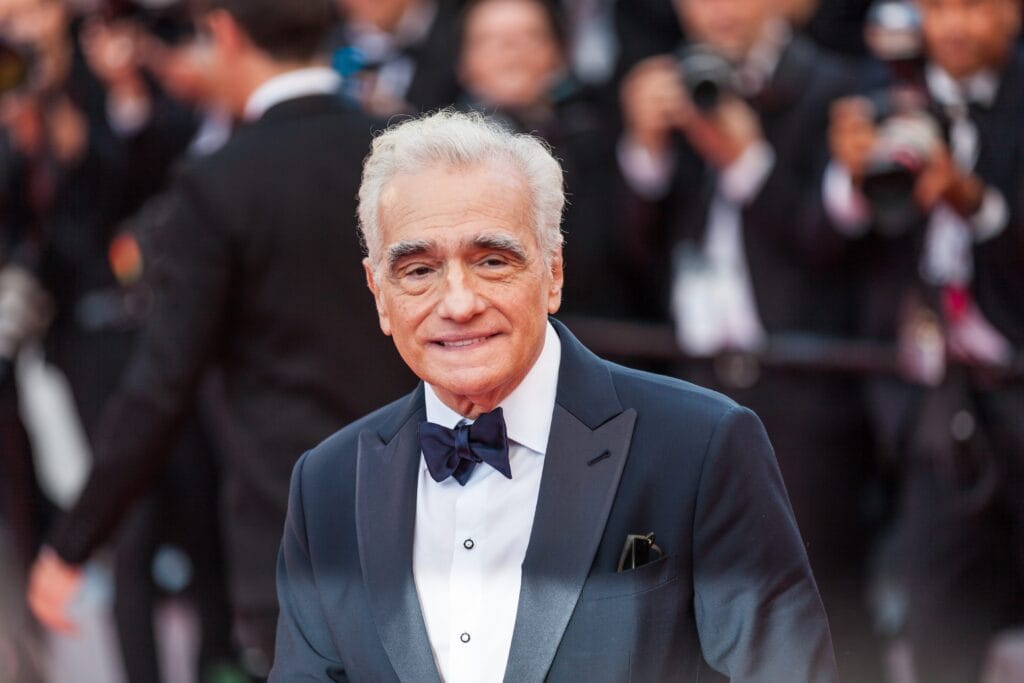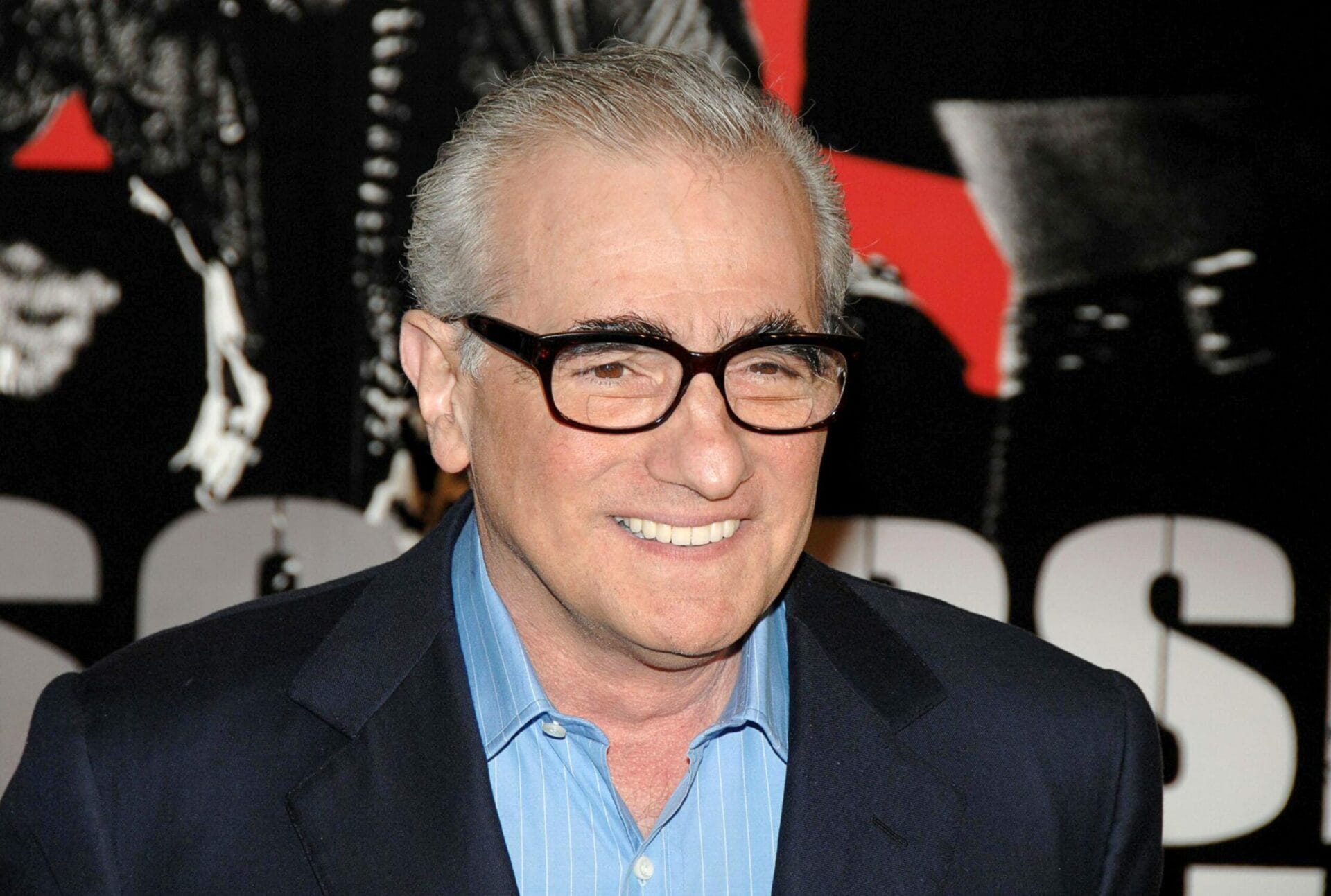Martin Scorsese was born in Flushing, Queens in New York City in 1942 to Italian-American parents. From a young age, Scorsese suffered from severe asthma that often kept him indoors. He was frequently ill and unable to play sports with other children. Instead, Scorsese found himself drawn to his family’s love of cinema, developing a passion for movies at an early age.
After his family moved to Little Italy, Scorsese was surrounded by the colorful characters and energy of the neighborhood. He spent much of his free time going to see double features at movie theaters or attending plays. By the time Scorsese was in eighth grade, he knew he wanted to make movies. He was enthralled with the power of cinema, stating, “I felt I could hold a mirror up to life.” Scorsese would go on to become one of America’s most acclaimed directors, shaping the landscape of modern cinema.

Education and Early Career
Martin Scorsese was born in 1942 in New York City. From a young age, he was interested in cinema and frequently went to see movies. After graduating high school, Scorsese attended New York University’s film school. Here he made his first short films, including What’s a Nice Girl Like You Doing in a Place Like This? (1963) and It’s Not Just You, Murray! (1964).
Scorsese’s student films already demonstrated his eye for visuals and editing. They also featured themes he would continue to explore throughout his career – Italian American identity, dark humor, violence, and Catholic guilt. After earning his MFA in film from NYU in 1966, Scorsese began his career directing documentaries and exploitation films. This early work allowed him to develop his skills while searching for his cinematic voice.
Breakthrough Films in the 1970s
In the 1970s, Martin Scorsese directed some of his most critically acclaimed and influential films. This decade marked Scorsese’s rise to prominence as an auteur director known for his gritty, realistic style.
Scorsese’s 1973 film Mean Streets was his first critical and commercial success. Set in Little Italy, New York, it follows small-time gangsters and their self-destructive lifestyles. Scorsese drew from his experiences growing up in this neighborhood to create an authentic world filled with violence, guilt, and Catholicism. Mean Streets established many of Scorsese’s trademarks like voice-over narration, rock music, and improvised dialogue.
Scorsese’s next major film Taxi Driver (1976) also depicted an unflinching look at New York City’s dark underbelly. The film focuses on Travis Bickle, a mentally unstable taxi driver played by Robert De Niro. Bickle descends into obsession and violence as he plots to assassinate a presidential candidate and “rescue” a young prostitute played by Jodie Foster. Scorsese used innovative camera techniques to portray Bickle’s warped perspective. Taxi Driver earned Scorsese the Palme d’Or at Cannes and his first Oscar nomination for Best Director.
Scorsese’s Raging Bull (1980) is considered one of the greatest films of all time. It chronicles the turbulent life of middleweight boxer Jake LaMotta, played in a tour de force performance by Robert De Niro. Scorsese used black-and-white cinematography and graphic violence to portray LaMotta’s brute force in the ring juxtaposed with his jealous rage outside of it. The film earned Scorsese his second Oscar nomination for Best Director and established his reputation as an uncompromising auteur.
1980s Downturn and Comeback
After the success of Taxi Driver, Raging Bull, and other acclaimed films in the 1970s, Scorsese hit a downturn in the 1980s. His films The King of Comedy and After Hours were both considered artistic and commercial failures upon their initial release. Criticism arose accusing Scorsese of repeating himself and being derivative of his earlier more successful work.
However, Scorsese made a major comeback in 1990 with his gritty gangster epic Goodfellas. Based on the true story of the rise and fall of mob associate Henry Hill, Goodfellas returned Scorsese to the top critically and commercially. Full of bravura sequences including the famous long take following Hill and his date Karen through the nightclub, the film is widely considered one of Scorsese’s masterpieces. Goodfellas cemented Scorsese’s reputation as an all-time great American filmmaker.
1990s Period Films
In the 1990s, Scorsese continued his string of ambitious and acclaimed films with period pieces set in the past.
His 1993 film The Age of Innocence, based on the novel by Edith Wharton, explored the rigid social mores of New York’s high society in the 1870s. The film starred Daniel Day-Lewis as Newland Archer, a young lawyer engaged to the beautiful May Welland (Winona Ryder) but who finds himself falling in love with her unconventional cousin Countess Olenska (Michelle Pfeiffer). Scorsese’s direction brought the elaborate costumes, sets, and manners of the era to vivid life. Though a departure from his prior works, The Age of Innocence earned him an Oscar nomination for Best Director.
Scorsese’s next major project was Kundun (1997), a biography of the 14th Dalai Lama’s early life in Tibet and eventual exile to India. With its lush cinematography and a score by Philip Glass, the film poetically depicted the young Dalai Lama’s trials during the Chinese invasion of Tibet in the 1950s. Kundun marked a temporary shift for Scorsese into more introspective territory compared to his recent crime films. While not a major commercial success, it represented an ambitious artistic effort.
2000s Successes
The 2000s marked a highly successful period for Scorsese, as he finally achieved the coveted Best Director Oscar that had eluded him for so long. In 2002, he directed Gangs of New York, an ambitious historical epic starring Leonardo DiCaprio and Daniel Day-Lewis. Though the film received mixed reviews, it demonstrated Scorsese’s ability to take on large-scale projects outside of his typical crime dramas.
Scorsese finally won the Best Director Oscar in 2006 for The Departed, a crime thriller remake of the Hong Kong film Infernal Affairs. The Departed became a major box office and critical hit, winning four Oscars including Best Picture. The success of The Departed cemented Scorsese’s legacy as one of the greatest living filmmakers. He continued his hot streak into the 2010s with more ambitious films that expanded his repertoire.
2010s Ambitious Projects
In the 2010s, Scorsese remained ambitious and prolific, directing several passion projects.
He first helmed the 3D fantasy adventure film Hugo (2011). This marked Scorsese’s first family film, and it centered on an orphan living in a Paris train station in the 1930s. Hugo demonstrated Scorsese’s willingness to continue innovating, and it earned critical acclaim along with 11 Academy Award nominations.
Scorsese’s next major work was The Wolf of Wall Street (2013), starring Leonardo DiCaprio. It portrayed the lavish lifestyle and extreme corruption of stockbroker Jordan Belfort. Known for its kinetic energy and raucous humor, The Wolf of Wall Street became one of Scorsese’s most commercially successful films. However, it also sparked controversy for seemingly reveling in excess.
In 2019, Scorsese directed the epic crime drama The Irishman, which spanned decades and used groundbreaking visual effects to de-age its cast. With a budget upwards of $159 million, The Irishman was one of Netflix’s most ambitious films to date. Though it failed to win Best Picture at the Oscars, The Irishman cemented Scorsese’s legacy and proved he could still craft an expansive vision late in his career.
Legacy and Impact
Martin Scorsese is one of the most influential and respected directors in film history. His gritty, intense storytelling style has inspired generations of younger filmmakers.
Scorsese is known for his technical mastery of cinematic techniques. His use of fluid camera work, rapid editing, and rich soundtracks have become trademarks of his recognizable directorial style. He showed younger directors how techniques like freeze frames, voiceovers, and handheld camera shots can enhance storytelling power.
The director has also made an indelible mark through his realistic portrayals of violence and ability to develop complex characters. Films like Taxi Driver, Raging Bull, and Goodfellas revealed a talent for bringing psychological depth to even antihero protagonists. His frank depictions of violence were considered groundbreaking.
By tackling themes of crime, guilt, machismo, and faith, Scorsese created a filmography that critiques masculine identities and shows the spiritual struggles of flawed characters. His subject matter connected with younger directors who also wanted to explore the dark side of human nature.
In the 1990s, Scorsese’s creative rebirth with films like The Age of Innocence showed his versatility. In the 2000s, he continued to inspire up-and-coming directors to take creative risks and tell original stories. His career stands as a model for generations of filmmakers.
Scorsese’s cinematic brilliance has cemented his place among the greatest American directors. His bold, uncompromising vision demonstrates the storytelling heights possible in film, creating a lasting legacy.
Directing Style and Themes
Martin Scorsese is known for his gritty, violent, and realistic portrayals of urban life, crime, and violence. He helped bring a new sense of realism to American cinema in the 1970s. His films often deal with themes of guilt, redemption, machismo, and Catholic concepts of right and wrong.
Scorsese’s visual style tends to be highly stylized. He makes use of rapid cuts, slow motion, freeze frames, and complex camera moves to bring energy and tension to his scenes. He is a master of tracking shots, often following characters through crowded spaces. His camerawork helps immerse the viewer in the gritty world of his films.
Violence is a recurring element in Scorsese’s work. He often shows the full impact and consequences of violence instead of sanitizing it. Scenes are gruesomely brutal but also emotionally compelling. Violence serves to drive the characters and narratives in films like Mean Streets, Taxi Driver, Raging Bull, Goodfellas, Casino, Gangs of New York, and The Departed.
Catholic guilt and redemption are also running themes in Scorsese’s work. Many of his flawed protagonists are looking for redemption. Scorsese’s strict Catholic upbringing in New York’s Little Italy informed this tendency in his work. Films like Mean Streets, Taxi Driver, and Raging Bull depict characters trying to find moral redemption through violence or suffering.
Scorsese’s male protagonists often display machismo and recklessness as they try to gain power or status. His focus on aggressive masculinity comes through in Raging Bull, Goodfellas, Casino, Gangs of New York, The Departed, and The Wolf of Wall Street. The protagonists embrace risk and violence as part of proving their manhood.
By delving into themes of guilt, faith, machismo, and redemption, Scorsese crafts psychologically complex characters grappling with their own inner demons. His technical mastery helps make the viewer feel the gripping power of violence and introspection in his cinematic worlds.
Personal Life
Martin Scorsese has been married five times. His first marriage was to Laraine Marie Brennan from 1965 to 1971. He was subsequently married to writer Julia Cameron from 1975 to 1977, actress Isabella Rossellini from 1979 to 1982, producer Barbara De Fina from 1985 to 1991, and finally to Helen Morris since 1999.
Scorsese has three daughters – Cathy Scorsese with Brennan, Domenica Cameron-Scorsese with Cameron, and Francesca Scorsese with De Fina. He also has a stepdaughter named Helen Morris with his current wife.
Outside of his directing work, Scorsese is known for his film preservation and protection efforts. He created The Film Foundation in 1990, a non-profit organization dedicated to film preservation and the protection of motion picture history. Through the foundation, Scorsese has helped restore over 900 films.
Scorsese has also advocated for artistic freedom against censorship, especially for films. He opposed the X rating system, spoke out against banning films, and argued for rating systems based on content rather than age. Scorsese aims to defend the art of cinema and the creative rights of filmmakers.
